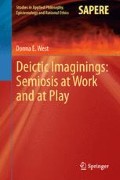Abstract
The origin and use of deictic terms, e.g., “I,” “you,” “this,” “that,” “here,” “there,” “now,” and “then” have fascinated linguists and philosophers for more than a century (Jespersen 1922/2008; Benveniste 1956/1971; Lyons 1968, 1977, 1995; Peirce 1867–1913; Bühler 1934/1990), given their unique and complex semantic and pragmatic interplay. Insights with respect to deictic use are first found in the linkage between the Greek meaning of “deixis/δειξισ” (“pointing out”) and its Latin translation: “demonstratio.”
Access this chapter
Tax calculation will be finalised at checkout
Purchases are for personal use only
Notes
- 1.
Origo is used in the Bühlerian sense of the “zero-point” of orientation, or the anchor in space and time from which events are observed.
- 2.
“Object” is used in the Peircean sense of referent, distinguished from a representation, and from the meaning accorded to the relationship between the representation and referent. “Object,” then, can refer to a person, an otherwise living or non-living entity, imagined or otherwise, a spatial or temporal location, or to an abstraction. .
- 3.
Tanz’ work with older children (from 3;5 to 5;0) and my own work with younger children (between 1;6 and 3;5) will be relied upon to demonstrate the shift in meaning of “that” in ontogeny. See Sect. 2.2 for further details regarding experimental design, findings, and implications.
- 4.
This characterization can be problematic in the absence of a differentiation between Self and Other (Mead 1934/1974).
- 5.
According to Peirce, “The icon has no dynamical connection with the object it represents; it simply happens that its qualities resemble those of that object…. The index is physically connected with its object; they make an organic pair, but the interpreting mind has nothing to do with this connection, except remarking it, after it is established. The symbol is connected with its object by virtue of the idea of the symbol-using mind, without which no such connection would exist” (1895: CP 2.299).
Author information
Authors and Affiliations
Corresponding author
Rights and permissions
Copyright information
© 2014 Springer-Verlag Berlin Heidelberg
About this chapter
Cite this chapter
West, D.E. (2014). Introduction. In: Deictic Imaginings: Semiosis at Work and at Play. Studies in Applied Philosophy, Epistemology and Rational Ethics, vol 11. Springer, Berlin, Heidelberg. https://doi.org/10.1007/978-3-642-39443-0_1
Download citation
DOI: https://doi.org/10.1007/978-3-642-39443-0_1
Published:
Publisher Name: Springer, Berlin, Heidelberg
Print ISBN: 978-3-642-39442-3
Online ISBN: 978-3-642-39443-0
eBook Packages: Humanities, Social Sciences and LawSocial Sciences (R0)

